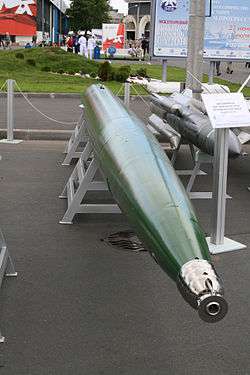VA-111 Shkval
| VA-111 Shkval | |
|---|---|
|
VA-111 Shkval | |
| Type | Supercavitating Torpedo |
| Place of origin | Russia |
| Service history | |
| In service | 1977-present |
| Used by | Russian Navy |
| Production history | |
| Designer | NII-24 research institute |
| Designed | 1960s-70s |
| Manufacturer | Tactical Missiles Corporation |
| Produced | 1977-present |
| Variants | Shkval 2 Shkval-E |
| Specifications | |
| Weight | 2,700 kg (6,000 lb) |
| Length | 8.2 m (26 ft 11 in) |
| Diameter | 533 mm (21 in) |
|
| |
| Effective firing range |
Shkval: 7 km (4.3 mi) Shkval 2: From 11–15 km (6.8–9.3 mi) |
| Warhead | Conventional explosive or nuclear |
| Warhead weight | 210 kg (460 lb) |
|
| |
| Engine | Solid-fuel rocket |
| Propellant | Solid-fuel |
| Speed |
Launch speed: 50 knots (93 km/h; 58 mph) Maximum speed: in excess of 200 knots (370 km/h; 230 mph) |
Guidance system | GOLIS autonomous inertial guidance |
Launch platform | 533 mm torpedo tubes |
The VA-111 Shkval (from Russian: шквал — squall) torpedo and its descendants are supercavitating torpedoes developed by the Soviet Union. They are capable of speeds in excess of 200 knots (370 km/h).[1]
Design and capabilities
Design began in the 1960s when the NII-24 research institute was ordered to produce a new weapon capable of engaging nuclear submarines. The merger of the institute and GSKB-47 created the Research Institute of Applied Hydromechanics, who continued with the design and production of the Shkval.[2]
Previously operational as early as 1977, the torpedo was announced as being deployed in the 1990s.[2] The Shkval is intended as a countermeasure against torpedoes launched by undetected enemy submarines.[2]


The VA-111 is launched from 533 mm torpedo tubes at 50 knots (93 km/h) before its solid-fuel rocket ignites and propels it to speeds of 200 knots (370 km/h). Some reports indicate that speeds of 250+ knots may be achieved, and that work on a 300-knot (560 km/h) version was underway.[3] This high speed is due to supercavitation, whereby a gas bubble, which envelops the torpedo, is created by outward deflection of water by its specially-shaped nose cone and the expansion of gases from its engine. This minimizes water contact with the torpedo, significantly reducing drag.[2]
Early designs may have relied solely on an inertial guidance system.[4][5] The initial design was intended for nuclear warhead delivery. Later designs reportedly include terminal guidance and conventional warheads.[6]
The torpedo steers using four fins that skim the inner surface of the supercavitation gas bubble. To change direction, the fin(s) on the inside of the desired turn are extended, and the opposing fins are retracted.[2]
Manufacture
The torpedo is manufactured in Kyrgyzstan by a state-owned factory. In 2012 the Russian government asked for a 75% ownership of the factory in exchange for writing off massive Kyrgyz debt to Russia.[7]
Espionage
In 2000, former U.S. Naval intelligence officer and an alleged DIA spy Edmond Pope (Captain, USN, retired) was held, tried, and convicted in Russia of espionage related to information he obtained about the Shkval weapon system. Russian President Vladimir Putin pardoned Pope in December 2000, allegedly on humanitarian grounds because he had bone cancer.[8][9]
Specifications
There are at least three variants:
- VA-111 Shkval – Original variant; GOLIS autonomous inertial guidance.
- "Shkval 2" - Current variant; believed to have additional guidance systems, possibly via the use of vectored thrust, and with much longer range.
- A less capable version currently being exported to various third world navies. The export version is referred to as "Shkval-E".
- Iran claimed it has created a version named Hoot.
All current versions are believed to be fitted only with conventional explosive warheads, although the original design used a nuclear warhead.
- Length: 8.2 m (26 ft 11 in)
- Diameter: 533 mm (21 in)
- Weight: 2,700 kg (6,000 lb)
- Warhead weight: 210 kg (460 lb)
- Speed
- Launch speed: 50 knots (93 km/h; 58 mph)
- Maximum speed: 200 knots (370 km/h; 230 mph) or greater
- Range: Around 11–15 km (6.8–9.3 mi) (new version). Older versions only 7 km (4.3 mi)[10]
See also
References
- ↑ "VA-111 Shkval Torpedo". www.militaryperiscope.com. Retrieved December 1, 2010.
- 1 2 3 4 5 "Iranian Navy Test-Fires New Home-Made Torpedo". Fars News Agency. 22 November 2014. Retrieved 18 May 2015 – via HighBeam Research. (subscription required (help)).
- ↑ Polmar, 2004, Cold War Submarines, p. 304; Baker, Combat Fleets of the World 2000–2001, p.581
- ↑ "КТРВ на МАКСе-2009 представит новую продукцию". www.aviaport.ru.
- ↑ "Подводные ракеты". www.flot.com.
- ↑ Polmar, 2004, Cold War Submarines, p. 304
- ↑ "Russia, Kyrgyzstan Clash Over Torpedo Plant". www.en.rian.ru 22/03/2012.
- ↑ "American Jailed as Spy in Moscow Is Freed on Putin's Orders; U.S. Welcomes Gesture". The New York Times. December 14, 2000.
- ↑ "Moscow 'Spy' Case Is Still a Mystery". The New York Times. January 15, 2001.
- ↑ Russia / USSR Post-World War II Torpedoes
Bibliography
- Polmar, Norman (2004). Cold War Submarines: The Design and Construction of U.S. and Soviet Submarines. Dulles: Potomac Books. ISBN 978-1-57488-594-1.
External links
| Wikimedia Commons has media related to VA-111 Shkval. |
- FAS page on the VA-111 Shkval underwater rocket
- Ashley, Steven (May 2001). "Warp Drive Underwater". Scientific American. Retrieved 2009-09-15. Preview
- Tyler, Patrick (December 1, 2000). "Behind Spy Trial in Moscow: A Superfast Torpedo". The New York Times.
